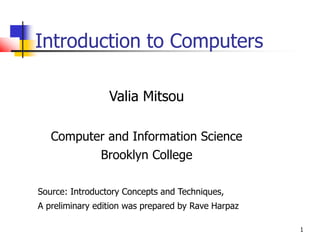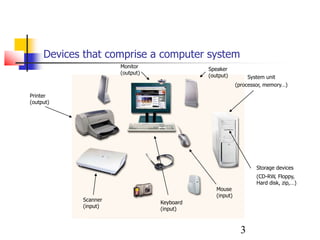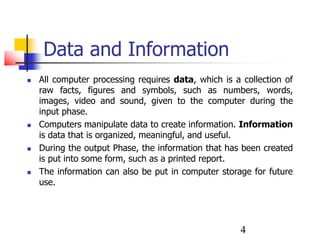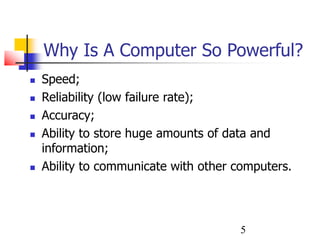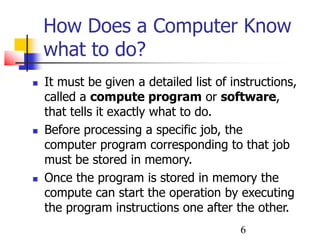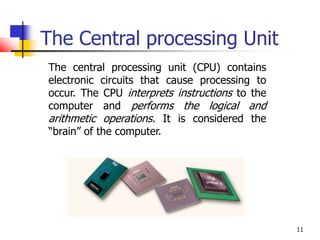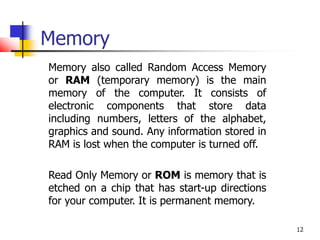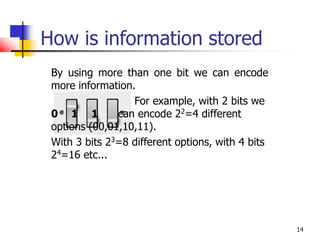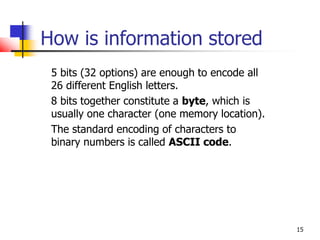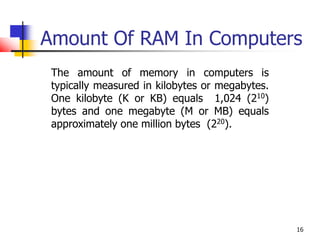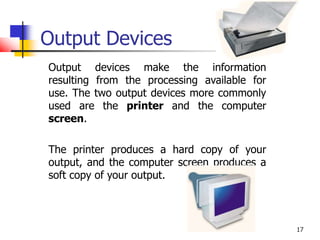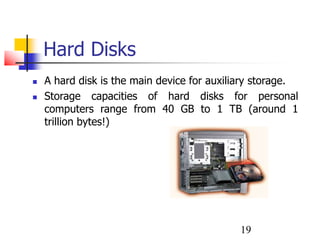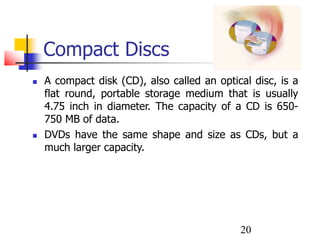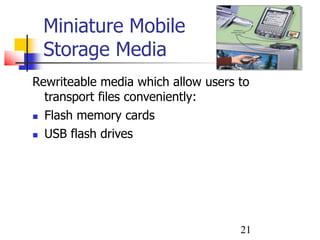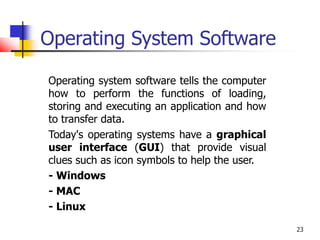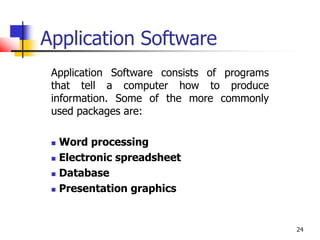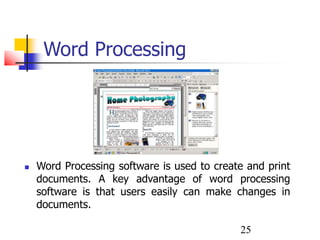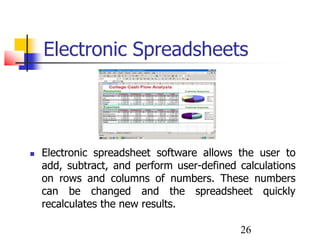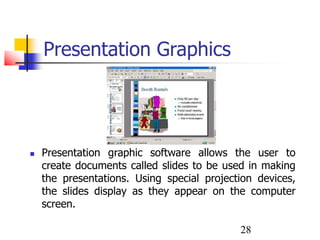Introtocomputernewpptfornewcomputerintro.ppt
- 1. 1 Introduction to Computers Valia Mitsou Computer and Information Science Brooklyn College Source: Introductory Concepts and Techniques, A preliminary edition was prepared by Rave Harpaz
- 2. 2 What Is A Computer? A computer is an electronic device that can: - accept data (input) - manipulate data (process) - produce information (output) and - store the results for future use (storage). Generally, the term is used to describe a collection of devices that function together as a system.
- 3. 3 Devices that comprise a computer system Printer (output) Monitor (output) Speaker (output) Scanner (input) Mouse (input) Keyboard (input) System unit (processor, memoryâĶ) Storage devices (CD-RW, Floppy, Hard disk, zip,âĶ)
- 4. 4 Data and Information ïŪ All computer processing requires data, which is a collection of raw facts, figures and symbols, such as numbers, words, images, video and sound, given to the computer during the input phase. ïŪ Computers manipulate data to create information. Information is data that is organized, meaningful, and useful. ïŪ During the output Phase, the information that has been created is put into some form, such as a printed report. ïŪ The information can also be put in computer storage for future use.
- 5. 5 Why Is A Computer So Powerful? ïŪ Speed; ïŪ Reliability (low failure rate); ïŪ Accuracy; ïŪ Ability to store huge amounts of data and information; ïŪ Ability to communicate with other computers.
- 6. 6 How Does a Computer Know what to do? ïŪ It must be given a detailed list of instructions, called a compute program or software, that tells it exactly what to do. ïŪ Before processing a specific job, the computer program corresponding to that job must be stored in memory. ïŪ Once the program is stored in memory the compute can start the operation by executing the program instructions one after the other.
- 7. 7 What Are The Primary Components Of A Computer ? ïŪ Input devices. ïŪ Central Processing Unit (containing the control unit and the arithmetic/logic unit). ïŪ Memory. ïŪ Output devices. ïŪ Storage devices.
- 8. 8 Input Devices ïŪ Keyboard. ïŪ Mouse.
- 9. 9 The Keyboard The most commonly used input device is the keyboard on which data is entered by manually keying in or typing certain keys. A keyboard typically has 101 or 105 keys.
- 10. 10 The Mouse Is a pointing device which is used to control the movement of a mouse pointer on the screen to make selections from the screen. A mouse has one to five buttons. The bottom of the mouse is flat and contains a mechanism that detects movement of the mouse.
- 11. 11 The Central processing Unit The central processing unit (CPU) contains electronic circuits that cause processing to occur. The CPU interprets instructions to the computer and performs the logical and arithmetic operations. It is considered the âbrainâ of the computer.
- 12. 12 Memory Memory also called Random Access Memory or RAM (temporary memory) is the main memory of the computer. It consists of electronic components that store data including numbers, letters of the alphabet, graphics and sound. Any information stored in RAM is lost when the computer is turned off. Read Only Memory or ROM is memory that is etched on a chip that has start-up directions for your computer. It is permanent memory.
- 13. 13 How is information stored Computers store information by using switches (on-off switches, like the ones used for turning on/off lights, except a lot smaller, and implemented with electronics - i.e. no moving parts). Information is encoded in binary. Binary digits 0 and 1 are called bits. With 1 bit we can encode 2 different options (true, false).
- 14. 14 How is information stored By using more than one bit we can encode more information. For example, with 2 bits we 0 1 1 can encode 22=4 different options (00,01,10,11). With 3 bits 23=8 different options, with 4 bits 24=16 etc...
- 15. 15 How is information stored 5 bits (32 options) are enough to encode all 26 different English letters. 8 bits together constitute a byte, which is usually one character (one memory location). The standard encoding of characters to binary numbers is called ASCII code.
- 16. 16 Amount Of RAM In Computers The amount of memory in computers is typically measured in kilobytes or megabytes. One kilobyte (K or KB) equals 1,024 (210) bytes and one megabyte (M or MB) equals approximately one million bytes (220).
- 17. 17 Output Devices Output devices make the information resulting from the processing available for use. The two output devices more commonly used are the printer and the computer screen. The printer produces a hard copy of your output, and the computer screen produces a soft copy of your output.
- 18. 18 Storage Devices Auxiliary storage devices are used to store data when they are not being used in memory. The most common types of auxiliary storage used on personal computers are hard disks, CD/DVD-ROM drives and miniature mobile storage media.
- 19. 19 Hard Disks ïŪ A hard disk is the main device for auxiliary storage. ïŪ Storage capacities of hard disks for personal computers range from 40 GB to 1 TB (around 1 trillion bytes!)
- 20. 20 Compact Discs ïŪ A compact disk (CD), also called an optical disc, is a flat round, portable storage medium that is usually 4.75 inch in diameter. The capacity of a CD is 650- 750 MB of data. ïŪ DVDs have the same shape and size as CDs, but a much larger capacity.
- 21. 21 Miniature Mobile Storage Media Rewriteable media which allow users to transport files conveniently: ïŪ Flash memory cards ïŪ USB flash drives
- 22. 22 Computer Software Computer software is the key to productive use of computers. Software can be categorized into two types: ïŪ Operating system software ïŪ Application software.
- 23. 23 Operating System Software Operating system software tells the computer how to perform the functions of loading, storing and executing an application and how to transfer data. Today's operating systems have a graphical user interface (GUI) that provide visual clues such as icon symbols to help the user. - Windows - MAC - Linux
- 24. 24 Application Software Application Software consists of programs that tell a computer how to produce information. Some of the more commonly used packages are: ïŪ Word processing ïŪ Electronic spreadsheet ïŪ Database ïŪ Presentation graphics
- 25. 25 Word Processing ïŪ Word Processing software is used to create and print documents. A key advantage of word processing software is that users easily can make changes in documents.
- 26. 26 Electronic Spreadsheets ïŪ Electronic spreadsheet software allows the user to add, subtract, and perform user-defined calculations on rows and columns of numbers. These numbers can be changed and the spreadsheet quickly recalculates the new results.
- 27. 27 Database Software ïŪ Allows the user to enter, retrieve, and update data in an organized and efficient manner, with flexible inquiry and reporting capabilities.
- 28. 28 Presentation Graphics ïŪ Presentation graphic software allows the user to create documents called slides to be used in making the presentations. Using special projection devices, the slides display as they appear on the computer screen.
